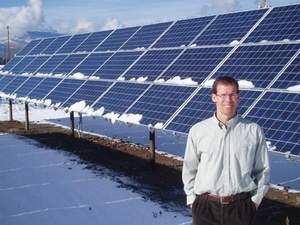Community solar project overcomes obstacles to provide equal access to net metering, part 2
 With a map of the solar array complete with serial numbers, each owner could visit the array and pick out which panels belong to him or her.
With a map of the solar array complete with serial numbers, each owner could visit the array and pick out which panels belong to him or her.
“At the same time, we didn’t want to create a system where if lightning struck one panel, that one person would be out of luck,” Martindale said. “It’s shared liability.”
Each panel costs $725 and the Clean Energy Collective floats all the tax credits and incentives it receives on to customers, Martindale said. It ends up saving buyers a lot in the end because the Collective is eligible for more rebates and incentives than individual homeowners can get.
The group pays for collective insurance, security and maintenance with money from an upfront fee it charges in the initial sale. It also takes 5 percent of the payments from Holly Cross with the aim of saving up enough money to cover the cost of replacing the inverter when the time comes.
That fund will keep the panels attractive to new buyers and make it easier for people to sell their panels if they ever decide to leave the valley, Martindale said.
Holy Cross pays 11 cents per kilowatt-hour for solar generation, which is greater than the retail rate for electricity in the area, Martindale said. The payments show up as credits on customers’ energy bills, so it’s not income to be taxed.
The idea behind the project is to increase the accessibility of net metering, open it up to everyone—not just homeowners with well-situated roofs.
“Someone like me, who first rented in the valley and now owns, but owns a small condo and will probably buy a house in the same valley and maybe a bigger house later, can take it with,” Martindale said.
Americans only stay in their homes an average of five years, Martindale said. Given that statistic, it’s hard to justify investing a lot of money into a solar array. The only way to recuperate the investment, typically, is to increase the cost of the home, which in this current market is very difficult to do.
The Roaring Fork Valley has particularly high real-estate costs, which has historically resulted in people doing as Martindale is doing—renting, buying something small, reinvesting the equity and slowly moving up, but never moving more than a few miles.
The Clean Energy Collective was created to offer a more flexible way to take advantage of net metering, Martindale said.
Story continues here.
Image courtesy of Clean Energy Collective.



